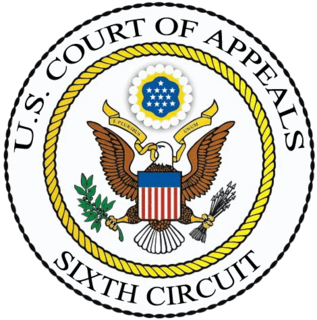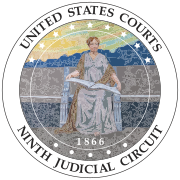The Miller test, also called the three-prong obscenity test, is the United States Supreme Court's test for determining whether speech or expression can be labeled obscene, in which case it is not protected by the First Amendment to the United States Constitution and can be prohibited.
Miller v. California, 413 U.S. 15 (1973), was a landmark decision of the U.S. Supreme Court modifying its definition of obscenity from that of "utterly without socially redeeming value" to that which lacks "serious literary, artistic, political, or scientific value". It is now referred to as the three-prong standard or the Miller test.

The Controlling the Assault of Non-Solicited Pornography And Marketing (CAN-SPAM) Act of 2003 is a law passed in 2003 establishing the United States' first national standards for the sending of commercial e-mail. The law requires the Federal Trade Commission (FTC) to enforce its provisions. Introduced by Republican Conrad Burns, the act passed both the House and Senate during the 108th United States Congress and was signed into law by President George W. Bush in December of 2003.
United States v. Dominguez Benitez, 542 U.S. 74 (2004), was a United States Supreme Court case in which the Court ruled that, in a criminal proceeding in federal court, a defendant who does not alert the district court to a possible violation of Rule 11 of the Federal Rules of Criminal Procedure must show on appeal that the violation affirmatively affected his rights in order to obtain reversal of his conviction by guilty plea. Rule 11, which pertains to criminal prosecutions in United States federal courts only, governs the offering of plea bargains to criminal defendants and the procedures district courts must employ to ensure that the defendant knows of and properly waives his trial-related constitutional rights.
Batson v. Kentucky, 476 U.S. 79 (1986), was a landmark decision of the United States Supreme Court ruling that a prosecutor's use of a peremptory challenge in a criminal case—the dismissal of jurors without stating a valid cause for doing so—may not be used to exclude jurors based solely on their race. The Court ruled that this practice violated the Equal Protection Clause of the Fourteenth Amendment. The case gave rise to the term Batson challenge, an objection to a peremptory challenge based on the standard established by the Supreme Court's decision in this case. Subsequent jurisprudence has resulted in the extension of Batson to civil cases and cases where jurors are excluded on the basis of sex.
Strauder v. West Virginia, 100 U.S. 303 (1880), was a landmark decision of the Supreme Court of the United States about racial discrimination and United States constitutional criminal procedure. Strauder was the first instance where the Supreme Court reversed a state court decision denying a defendant's motion to remove his criminal trial to federal court pursuant to Section 3 of the Civil Rights Act of 1866.
United States v. Booker, 543 U.S. 220 (2005), is a United States Supreme Court decision on criminal sentencing. The Court ruled that the Sixth Amendment right to jury trial requires that other than a prior conviction, only facts admitted by a defendant or proved beyond a reasonable doubt to a jury may be used to calculate a sentence exceeding the prescribed statutory maximum sentence, whether the defendant has pleaded guilty or been convicted at trial. The maximum sentence that a judge may impose is based upon the facts admitted by the defendant or proved to a jury beyond a reasonable doubt.

United States v. Extreme Associates, 431 F.3d 150, is a 2005 U.S. law case revolving around issues of obscenity. Extreme Associates, a pornography company owned by Rob Zicari and his wife Lizzy Borden, was prosecuted by the federal government for alleged distribution of obscenity across state lines. After several years of legal proceedings, the matter ended on March 11, 2009, with a plea agreement by Rob Zicari and Lizzy Borden.
United States v. Gonzalez-Lopez, 548 U.S. 140 (2006), is a United States Supreme Court ruling that the erroneous deprivation of a defendant's attorney of choice entitles him to a reversal of his conviction under the Sixth Amendment to the United States Constitution.
Blockburger v. United States, 284 U.S. 299 (1932), was a case in which the Supreme Court of the United States set an important standard to prevent double jeopardy.

United States v. Weitzenhoff, 35 F.3d 1275 is a legal opinion from the Ninth Circuit Court of Appeals that addresses the confusing mens rea requirement of a federal environmental law that imposed criminal sanctions on certain polluters. The main significance of the court's opinion was that it interpreted the word "knowingly" in the statute to mean a general awareness of the wrongfulness of one's actions or the likelihood of illegality, rather than an actual knowledge of the statute being violated. Circuit Court Judge Betty Binns Fletcher authored the majority's legal opinion in this case.

American Booksellers Foundation for Free Expression v. Strickland, 560 F.3d 443, is a decision of the Sixth Circuit Court of Appeals involving a constitutional challenge—both facially and as-applied to internet communications—to an Ohio statute prohibiting the dissemination or display to juveniles of certain sexually-explicit materials or performances. The Sixth Circuit panel declined to resolve the constitutional issue but, instead, certified two questions to the Ohio Supreme Court regarding the interpretation of the statute. The Ohio Supreme Court answered both questions affirmatively and placed a narrowing construction on the statute. Since the Ohio Supreme Court's decision, the Sixth Circuit has not reheard the case.

Gordon v. Virtumundo, Inc., 575 F.3d 1040, is a 2009 court opinion in which the United States Court of Appeals for the Ninth Circuit addressed the standing requirements necessary for private plaintiffs to bring suit under the Controlling the Assault of Non-Solicited Pornography and Marketing Act of 2003, or CAN-SPAM Act of 2003, 15 U.S.C. ch. 103, as well as the scope of the CAN-SPAM Act's federal preemption. Prior to this case, the CAN-SPAM Act's standing requirements had not been addressed at the Court of Appeals level, and only the Fourth Circuit had addressed the CAN-SPAM Act's preemptive scope.

The Supreme Court of the United States handed down eight per curiam opinions during its 2014 term, which began October 6, 2014 and concluded October 4, 2015.
Davis v. Ayala, 576 U.S. 257 (2015), was a case in which the Supreme Court of the United States upheld a death sentence of a Hispanic defendant despite the fact that all Blacks and Hispanics were rejected from the jury during the defendant's trial. The case involved a habeas corpus petition submitted by Hector Ayala, who was arrested and tried in the late 1980s for the alleged murder of three individuals during an attempted robbery of an automobile body shop in San Diego, California in April 1985. At trial, the prosecution used peremptory challenges to strike all Black and Hispanic jurors who were available for jury service. The trial court judge allowed the prosecution to explain the basis for the peremptory challenges outside the presence of Ayala's counsel, "so as not to disclose trial strategy". Ayala was ultimately sentenced to death, but he filed several appeals challenging the constitutionality of the trial court's decision to exclude his counsel from the hearings.
Kingsley v. Hendrickson, 576 U.S. 389 (2015), is a United States Supreme Court case in which the Court held in a 5–4 decision that a pretrial detainee must prove only that force used by police is excessive according to an objective standard, not that a police officer was subjectively aware that the force used was unreasonable.
McFadden v. United States, 576 U.S. 186 (2015), was a United States Supreme Court case in which the Court held that section 841 of the Controlled Substances Act requires the government to prove that to be in criminal violation, a defendant must be aware that an analogue defined by the Controlled Substance Analogue Enforcement Act with which he was dealing was a controlled substance.
Ginzburg v. United States, 383 U.S. 463 (1966), was a decision by the United States Supreme Court involving the application of the First Amendment to Federal obscenity laws. One of a trio of cases, Ginzburg was part of the Supreme Court's attempt to refine the definitions of obscenity after the landmark 1957 case Roth v. United States.
Romag Fasteners, Inc. v. Fossil, Inc., 590 U.S. ___ (2020), was a United States Supreme Court case related to trademark law under the Lanham Act. In the 9–0 decision on judgement, the Court ruled that a plaintiff in a trademark infringement lawsuit is not required to demonstrate that the defendant willfully infringed on their trademark to claim lost profit damages.





